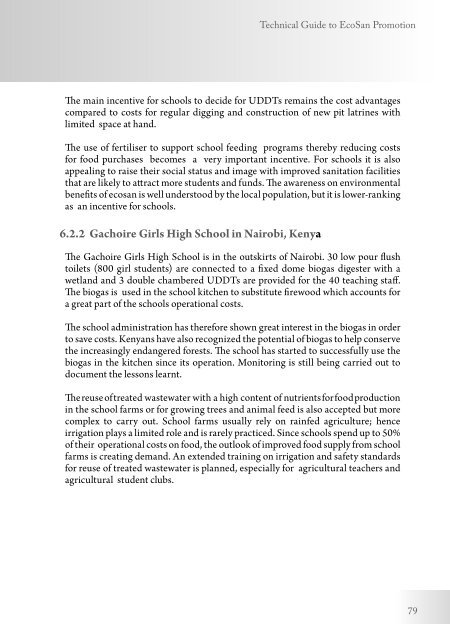Technical Guide to EcoSan Promotion
Technical Guide to EcoSan Promotion
Technical Guide to EcoSan Promotion
Create successful ePaper yourself
Turn your PDF publications into a flip-book with our unique Google optimized e-Paper software.
<strong>Technical</strong> <strong>Guide</strong> <strong>to</strong> <strong>EcoSan</strong> <strong>Promotion</strong><br />
The main incentive for schools <strong>to</strong> decide for UDDTs remains the cost advantages<br />
compared <strong>to</strong> costs for regular digging and construction of new pit latrines with<br />
limited space at hand.<br />
The use of fertiliser <strong>to</strong> support school feeding programs thereby reducing costs<br />
for food purchases becomes a very important incentive. For schools it is also<br />
appealing <strong>to</strong> raise their social status and image with improved sanitation facilities<br />
that are likely <strong>to</strong> attract more students and funds. The awareness on environmental<br />
benefits of ecosan is well unders<strong>to</strong>od by the local population, but it is lower-ranking<br />
as an incentive for schools.<br />
6.2.2 Gachoire Girls High School in Nairobi, Kenya<br />
The Gachoire Girls High School is in the outskirts of Nairobi. 30 low pour flush<br />
<strong>to</strong>ilets (800 girl students) are connected <strong>to</strong> a fixed dome biogas digester with a<br />
wetland and 3 double chambered UDDTs are provided for the 40 teaching staff.<br />
The biogas is used in the school kitchen <strong>to</strong> substitute firewood which accounts for<br />
a great part of the schools operational costs.<br />
The school administration has therefore shown great interest in the biogas in order<br />
<strong>to</strong> save costs. Kenyans have also recognized the potential of biogas <strong>to</strong> help conserve<br />
the increasingly endangered forests. The school has started <strong>to</strong> successfully use the<br />
biogas in the kitchen since its operation. Moni<strong>to</strong>ring is still being carried out <strong>to</strong><br />
document the lessons learnt.<br />
The reuse of treated wastewater with a high content of nutrients for food production<br />
in the school farms or for growing trees and animal feed is also accepted but more<br />
complex <strong>to</strong> carry out. School farms usually rely on rainfed agriculture; hence<br />
irrigation plays a limited role and is rarely practiced. Since schools spend up <strong>to</strong> 50%<br />
of their operational costs on food, the outlook of improved food supply from school<br />
farms is creating demand. An extended training on irrigation and safety standards<br />
for reuse of treated wastewater is planned, especially for agricultural teachers and<br />
agricultural student clubs.<br />
79

















